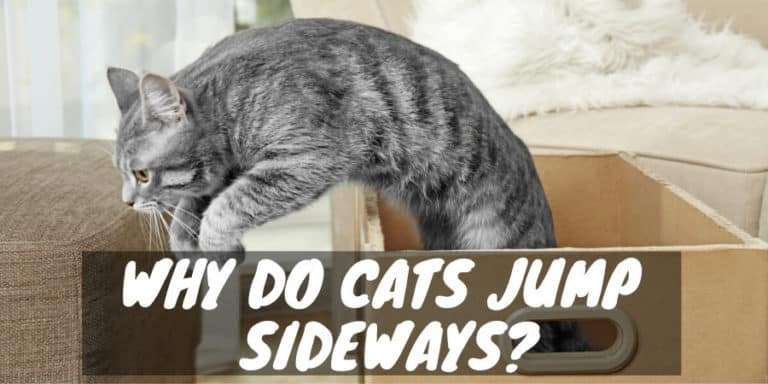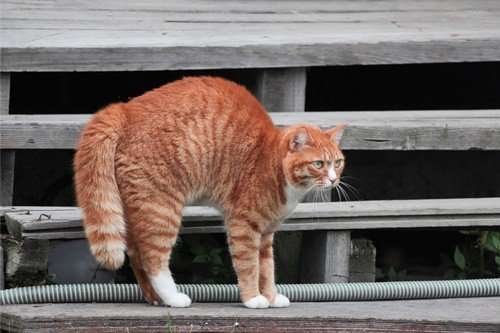Why Do Cats Rub Against Your Leg
When a cat rubs his head or the side of his chin against you, the furniture, or any object, he is actually depositing his scent on them as part of territorial marking. He uses his glands on his forehead and around his mouth and chin. These glands produce chemicals called pheromones, which he transfers by rubbing against objects. Cats can tell how long ago a scent was left and how much attention they need to pay to the warning.
It May Mean That Your Cat Has Health Issues
A cat walking sideways may also be a warning sign of an underlying health condition.
If your cat is walking sideways and is also manifesting the following signs then she may be suffering from the feline vestibular disease:
- loss of body coordination
- falling or circling to one side
- the eyes are darting back and forth, also called nystagmus
- the head is tilting
- nausea
- vomiting
Cats lose their balance because of a damaged or diseased vestibular apparatus that is located in the inner ear, the part that is responsible for maintaining balance, and a cats sense of direction and orientation. The feline vestibular disease affects cats regardless of age and usually caused by middle or inner ear infections. The growth of tumors and exposure to toxins and drugs may also contribute to symptoms of the disease although a majority of cases were attributed to unknown causes.
Cats Arch Their Back When They Are Stretching
In some situations, its best to not overthink the behavior of your cat. Sometimes your cats arched back means absolutely nothing besides needing a good stretch.
Since cats have a total of sixty vertebrae and more flexibility than humans do, a cats stretch can appear somewhat extreme even though their stance simply symbolizes that they feel tired.
You may observe your cat standing there with their paws spread out, their backs arched, their nose buried in the floor, and their tail standing straight up in the air and wonder what in the world they are doing.
You may even glance around expecting to see a mouse or bird nearby.
However, they arent seeking prey, nor are they in danger. Chances are that they arent even in a playful mood.
On the contrary, they are probably ready to take a nap.
You May Like: Is Blue Buffalo Good Cat Food
What Do You Mean By Cat Sideways Hop
Sideways Hop is one of the cutest and funniest things that young cats do to show their playfulness. It is not a universal trait of cats, but playful cats tend to perform this often.
In this movement, the cat raises its tail, stretches the legs, face sideways, and arch the back. It may then either move towards you or away from you in a hopping fashion.
It is generally the cats call for you to play along. Many cat owners refer to this movement as sidewinding.
It is commonly not associated with any aggression. Still, a hissing sound or growling may indicate hostility towards a person or pet.
If your cat is playful by showing this unique movement, you can repeat the same movement to play along with the cat.
Why Some Dogs Walk Sideways

A video posted by Cheyenne The Pointer on Aug 29, 2013 at 7:50am PDT
Now that you know about the different types of dog gaits, you may be wondering: why do some dogs walk sideways? Well, if you watch people walk down the street, youll notice that everyone has a distinct walk. Dogs are the same way their shape and size, the condition of their joints, and their training all contribute to their particular way of walking.
For the most part, dogs who crabwalk with their back legs a bit off to one side from the front are just built that way. In particular, dogs with short body length and long legs can have a hard time trotting in a straight line because their back legs interfere with their front legs. Some types of dog are more likely to walk sideways:
- Border collies
- Pointers
- Vizslas
Any dog with long legs may be prone to crabbing, which helps them avoid tripping over their own feet. The body twists slightly to allow the back feet to pass to one side of the front feet. Dogs who walk sideways are actually moving forward and laterally at the same time .
Read Also: Is Blue Buffalo Good Cat Food
When They Become Excited:
Cats are truly fascinating animals. These creatures in particular can get very excited when playing with their favorite human or pets and will often show this excitement by performing a specific action.
When the cat hops around sideways, you should accept it because we all know that cats do weird things sometimes!
What Happens If A Cat Gets Stung By A Bee
You should also closely inspect the site of the sting on your cat: Bees leave their stingers behind, while wasps and other flying insects keep their stingers intactand can therefore sting more than once. Typically a sting will result in a localized reaction, including mild swelling and tenderness.
Recent Posts
Read Also: How To Stop Cat Scratching Door At Night
Reason : Your Cat Wants Attention
What happens when your cat arches their back and runs sideways at you?
My guess is that you probably dont just ignore it!
Instead, you laugh, play with your cat or if youre like most of the world may even decide to take a video to upload on YouTube! Whatever you do, the sideways run usually results in some kind of positive attention towards your cat!
Cats have several ways to get your attention including flopping down in front of you or my personal favorite trilling! The crabwalk is just another method that some cats will use more than others to get your attention and start a play session!
Why Do Cats Roll Over And Expose Their Stomachs
A rare form of greeting, the ultimate compliment that a cat can pay to a human. This body language shows how much he cares for you and how comfortable he is around you. Totally exposing the stomach reveals how secure he feels, because the stomach area is the must vulnerable body part of the cat. He can be asking for a caress, inviting you to play with him, or may want the stomach area stroked. If he sleeps on his back this way, his trust in you is in the stratosphere.
Don’t Miss: How Much Dry Food Should A Cat Eat
Why Do Cats Knead
That loud purring followed by the sharpening of claws on some soft spot of your body is called “milk-treading.” When you relax and sit quietly, you’re giving your cat the same signal he got from his mother when he was a kitten – that his mother was ready to let him suckle. A nursing kitten instinctively uses his paws to draw out the milk, gently pushing on his mother’s stomach to increase the milk flow. When older cats behave this way, it’s a good sign that they’re happy, content, and probably recalling their kittenhood.
Why Do Cats Hop On Hind Legs
There can be several reasons for which the cats hop on their hind legs. It is incredibly harmless in most of the case.
However, you have to know that the origin of this move was somewhat tactical.
When the cats were in danger from predators, jumping or standing on their hind legs will make them appear more prominent. This activity was strictly there to ward off any unwanted animals in their surroundings.
But when the cats are all playful and happy, the cats might be doing this just for getting a few extra brownie points.
Whenever they know that you will feed them or play with them, they will perform this action to get your attention.
Read Also: How Cold Can Cats Handle
Is It Normal For An Adult Cat To Jump Sideways
Adult Cats Can Jump Sideways, Too! Your adult cat is a lot mellower than he was as a kitten. He still loves to play, but hes also grown more confident in his body language and ability to express himself, so he doesnt jump around and roughhouse as much as he used to. So when he puffs up his tail and arches his back, you know somethings wrong.
What Does It Mean When A Cat Arching Its Back

You may notice your cat arching its back during play. This is especially likely among kittens. For kittens, play is a practice run for life as an adult cat as games teach them hunting techniques. Even an adult cat will play to sate its hunting instincts.
Also Check: How Can You Tell The Gender Of A Cat
Why Do Cats Do That Silly Sideways Walk
Modi Ramos16562
Cats do lots of super cute things. Theyll puff up and arch their backs when they become startled. Theyll knead us with their paws and make us feel all warm and fuzzy inside, too. And another cute thing that they do? That adorable sideways jump that makes our hearts pitter patter. Have you ever wondered why it is that our feline friends will display this silly behavior? Keep reading to find out why our kitties sometimes make us smile with that cute little sideways walking jump.
So, first off, what is the sideways cat walk?
Some people might also refer to this sideways cat walk as the crab walk, and that makes perfect sense if you know exactly what Im talking about! But, of course, Ive included a clip for you courtesy of YouTube so you can get a better idea
This little cutie is well on their way to becoming a master crab walker!
Your feline friend is a naturally playful little being. For them, they can sometimes display this cute crustacean-like movement when they are excited and something triggers their innate desire to play. Dont allow those aloof and distant cats to fool you, most cats are quite playful at heart regardless of age. My older kitty Mr. Purple is nine and he still does this often and I love it! Typically when its when hes having a good romp with my Chihuahua.
Cats jump sideways usually when theyre startled
Why Do Cats Do The Sideways Hop
Cats may appear aloof but they also tend to be affectionate and playful. They have body language and behavior that are confusing but also amusing to see. The sideways hop, for instance, is among one of the entertaining movements that we often observe among cats and kittens.
Here are the probable reasons why cats do the sideways hop:
Read Also: How Old Is A 12 Year Old Cat
Do All Adult Cats Sideways Run And Hop
Every cat is a little different with their own style of communication and not every cat may decide to work the sideways walk into their body language routine- at least when it comes to playing.
The arched back and sideways run is practical and instinctual as a fear response and so just about every cat may take this position when theyre suddenly startled and feel threatened, regardless of their individual personality.
But when it comes to playtime, some cats just find the crabwalk more fun than others. As we saw in the video at the top of this page of the cat with an almond, its a go-to move for some felines while others may never do it all!
Its A Veterinary Issue
There are also some neurological disorders, illness, and injuries that could be behind the behavior. You should call your veterinarian if it happens often or if it happens after theyve finished playing. This can happen because of a stroke, a bad tooth or an ear infection. Owners of outdoor cats shouldnt rule out injury, either. The pet could have been hit by something or been hurt in a fight with another animal.
We hope that youve found this post helpful. Weve got lots of other posts on this website which we think makes traveling and living with cats easier . Well list some of our more popular ones below.
Read Also: Blue Wilderness High Protein Cat Food
Cats Arch Their Backs When They Are Afraid Of A Potential Threat
Yes, the stereotypical hissing cat with an arched back that is portrayed on Halloween is actually symbolic of a known cat behavior that can occur in any cat that is experiencing fear, regardless of whether they are a black cat or just your average tabby.
When cats arch their backs, it makes them appear larger than they really are, which is why cats tend to arch their backs when they feel as though they are in danger.
However, its possible to spot the difference between a fearful arch and a playful arch by the accompanying behavior.
When cats are afraid, their arched back will be coupled with hissing, spitting, and even a puffed tail.
Although you may have a good rapport with your cat, youll want to avoid them when they are in this state as they may inadvertently scratch or bite you.
Even the most docile cat can become aggressive if they feel like theyre in danger.
Your Cat Feels Scared Or Threatened
Of course, it probably doesnt come as much of a surprise that cats will sometimes fluff up their tails and walk or run sideways when they are feeling threatened. Are there any larger animals in your home, such as a dog? Were there any loud noises that may have startled your kitty? When your cat arches its back and puffs its fur, it has the ability to look larger than it really is. This is a means of defense when it feels threatened. It may move side to side instead of forward and backward in order to maintain its arched position, or perhaps to distract a potential threat.
Read Also: Buffalo Blue Cat Food Reviews
Why Makes A Cat Purr
Cats are the only animals who purr. Contrary to popular belief, purring isn’t speaking. The purr comes from two membrane folds, called false vocal cords, that are situated in the larynx behind the actual vocal cords. Cats purr 26 cycles per second, the same as an idling diesel engine. Cats purr both when inhaling and exhaling, keeping the mouth completely closed. Scientists believe purring is produced by blood in a large vein in the chest cavity that vibrates and is then magnified by air in the windpipe. Kittens are born blind and deaf, but the vibrations of their mother’s purring is a physical signal that the kittens can feel. It acts as a homing device, signaling them to nurse. Kittens begin purring at about one week old then it’s a signal to the mother cat that they’re getting their milk and are content. Since purring is non-vocal, it doesn’t interfere with the suckling. Contrary to another popular belief, cats don’t purr purely for pleasure. Be alert: a deep purr can indicate that a cat is in pain or distress. Female cats will purr when in labor. Cats may purr in fear or anxiety. They will also purr in anticipation of being fed or stroked. Big African cats only purr in short bursts, but the house cat can purr for hours. Curiously, scientists tell us that a cat never purrs when alone.
Cat Arching Its Back In Pain

Coupled with an arched back, these actions suggest a cat is in pain:
- Agitation and reluctance to settle
- Uncharacteristic aggression
- Depression and lethargy
- Excessive grooming or licking
Cats mask any sign of discomfort. Felines worry that demonstrating pain is showing weakness. This opens the cat up to attacks from predators.
A cat arching its back in pain is clearly in distress. According to the Journal of Feline Medicine and Surgery, pain is difficult to manage as cats are allergic to many painkilling drugs and anesthetics.
You May Like: How To Tell Kitten Sex
Felines Arch Their Backs When They Are Playing
Felines can also arch their backs if theyre in the mood to play. This may be in response to playing together with another cat, with their human, or simply with a ball of yarn.
Kittens are especially known for playful arching of the back that usually occurs when they are playing with other members of the litter or practicing catching mice.
You can tell when your cats arched back is the result of playing by paying attention to their demeanor.
If they are bouncing around and enjoying your company or the companionship of another cat, you can most likely continue to happily engage with them without the fear of being bitten.
When Your Cat Is Trying To Intimidate Another Animal
If you want your kitten to become instant friends with the new puppy youve adopted, think again. Walking sideways can be a show of dominance and strength too. You see, when your kitty walks sideways, it does that with an arched back and a fluffed-up tail.
In other words, its attempting to make itself look bigger and far more frightening than it is. And, such a show is put on not for your benefit. Instead, it is to put someone or something in its place. So, the new pet is welcome to a select corner of the house until your purr-fect kitty feels otherwise.
Don’t Miss: Cat Shirt Pattern
Why Do Cats Get Stuck In Trees
Their claws are constructed for climbing up. When they attempt to climb down headfirst , it’s impossible for them because the claws are curved the wrong way. Eventually, a cat will figure out how to go down the correct way – shimmying down backward so that the claws will cling to the bark of the tree.